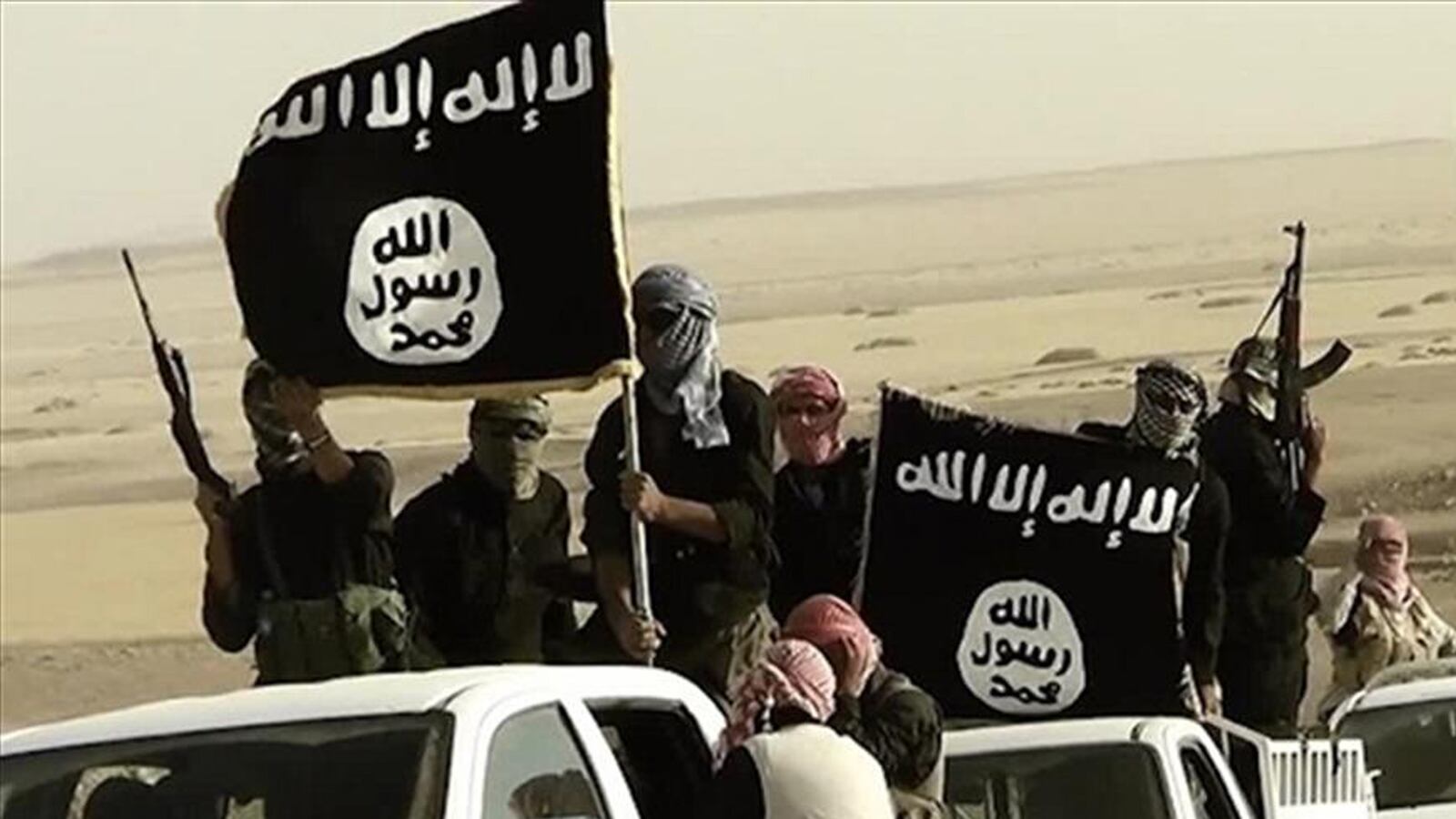American airpower will be the centerpiece of U.S. direct action against the so-called Islamic State. That much, at least, the U.S. government made clear Monday night with the launch of U.S. airstrikes on Syria. American bombers, sea-launched Tomahawk Land Attack Missiles, F-15s, F-16s, F/A-18s, unmanned aircraft, and Arab allies from bases throughout the Persian Gulf region attacked an initial set of roughly 20 primarily fixed targets—logistical hubs, headquarters, training camps, and other ISIS infrastructure—in Raqqa and other areas in Syria.
Meanwhile, the United States has flown hundreds of sorties against ISIS forces in Iraq, but Iraqi security forces have yet to retake major cities. What effect will airstrikes have on ISIS? Will they “degrade” or “defeat” the group? To understand the implications we first must understand ISIS as an organization: How it fights, how it is organized, and ultimately how it might be vulnerable to a long-term bombing campaign.
ISIS’s battlefield success and political resiliency depend on a sophisticated but partially decentralized structure that recommends a different form of targeting than in past U.S. decapitation efforts against al Qaeda and its affiliates. ISIS’s offensive success, especially in Iraq, is attributed to a mix of subversion, guerrilla warfare, and light infantry tactics yielding a surprisingly effective irregular warfare strategy. Its defensive strength derives from its robust local and international recruiting efforts and its success at retaining guerrilla resilience even as it undertakes a state-building project.
Understanding how ISIS pairs differing tactics with specific military objectives reveals where U.S. and allied airpower can impede ISIS’s operations and where it will have a secondary or negligible role in support of the operations of local ground forces. ISIS’s organizational sophistication and the battlefield tactics it employs provide unique roles for airpower as well as challenges for the types of campaigns the United States has waged against other insurgencies and terrorist networks.
Harassment attacks are an important part of ISIS operations, serving both to prepare enemy territory for conquest, as in Deir ez-Zor and Mosul this spring, and to terrorize the population and tie down hostile forces in areas beyond ISIS’s realistic capacity for territorial acquisition, as in Erbil and Baghdad. These tactics draw on ISIS’s long legacy of clandestine operations, incorporating suicide bombings, assassinations of local leaders and security force personnel, and raids on major and minor military targets. Frequently using local cells and militants blending in with the civilian population, “these attacks inflict great psychological damage on our troops,” an Iraqi army captain who served in Mosul said this year in an interview. Assassinations of community leaders both weaken local coordination against ISIS and deter potential informants. Although ISIS does employ these tactics in Syria, it is less dependent on them there, especially when it is fighting rival armed groups rather than the Syrian regime. It can more easily augment its tactics, too, with the spoils of its conventional armies seized from Syrian and Iraqi government forces.
ISIS follows up bombings, raids, and ambushes with larger coordinated offensives incorporating a variety of specialized units and modified forms of light infantry tactics. Extensive use of technicals, pickup trucks with heavy machine guns, and even anti-aircraft guns allows ISIS to move quickly and concentrate firepower, while many of its dismounted soldiers are skilled sappers or shock troopers, coordinating with suicide vehicle-borne improvised explosive devices (S-VBIEDs) to break through well-defended positions. ISIS has employed these tactics to great effect against Iraqi security forces in Tikrit and against non-state rivals such as the Kurdish People’s Protection Units (YPG) in northern Syria.
In Syria, ISIS is also much more willing to mass forces and use captured heavy weapons such as tanks and artillery to contest and besiege regime and rival non-state territories. Most prominently in recent weeks, ISIS has used artillery captured from Syrian army brigades 93 and 121 to besiege and capture Taqba airbase, and it also has used these arms and tactics against Meneg air base and Hasakeh. ISIS frequently deploys these heavy weapons where it has pinned the regime to a fixed, well-defended position such as a military base that is less vulnerable to raiding and clandestine terrorism tactics. The group also may deploy heavy weapons against non-state groups that are less able to defend against them, such as in Kobane, where ISIS used T-55s, captured Iraqi security force Humvees, and rocket artillery attacks against YPG. Although ISIS captured significant heavy artillery and large numbers of armored vehicles in Iraq and occasionally uses them there, it has redirected many of these weapons to Syria, where they are most useful.
ISIS’s military effectiveness is due not simply to equipment or tactics available. To coordinate complex military operations across multiple theaters, the group relies heavily on its midlevel leadership. Although much international focus remains on the policymaking leadership and ideologists, ISIS’s midlevel leadership consists of one-time Baathist army officers who were recruited by ISIS’s former leader, Abu Omar al-Baghdadi, in late 2009 and experienced insurgents from the jihadist movement in Iraq and abroad. Although ISIS’s political leadership and a variety of financial and logistical mechanisms appear centralized, battlefield leadership and initiative is delegated in large part to these midlevel commanders, with significant autonomy to interpret the intent and dispose of the resources of high command.
Faced with this opponent, the United States has a variety of military options for using its aerial and standoff firepower. In Iraq, it appears to pursue the immediate option of an expansion of the types of attacks used around Erbil, the Mosul and Haditha Dams, Sinjar, and Amerli. Hours before the strikes in Syria, U.S. forces attacked ISIS Humvees, armored vehicles and technicals, which are modified civilian vehicles, southwest of Kirkuk. These attacks primarily target vehicles, heavy weapons, and emplacements in relatively open territory, which are easily visible to aerial surveillance as well as ground forces. When used outside of major urban areas, they minimize the risk of civilian casualties and requirements for granular intelligence. Expanding these attacks to more areas in Iraq and Syria would allow for the U.S. to severely hamper ISIS’s large-scale offensive operations.
ISIS does not depend on heavy weapons in Iraq, but it relies heavily on technicals to mass forces before capturing new territory. Denying ISIS’s ability to traverse open ground en masse would severely degrade its ability to expand its territory or to hold areas outside population centers from ground assault, as was the case in the Mosul Dam.
Although the experience of the United States’ extensive history of counterterrorism operations lends itself to a campaign oriented around decapitation of high-level leadership, strikes focusing on on ISIS’s command and control infrastructure could prove more effective by degrading the ability of the group’s midlevel commanders to coordinate battlefield activity. Early strikes in Raqqa appear so far to focus on fixed infrastructure and other static targets, but given ISIS’s insurgent experience at operating underground, seeking out these fixed targets will yield diminishing returns. Although leadership strikes modeled on U.S. counterterrorism operations against al Qaeda and its affiliates could have high political and psychological value, these types of decapitation campaigns are often lengthy, intensive efforts with uncertain results. The significant autonomy enjoyed by ISIS’s ground commanders makes them critically important to their military operations but also potentially resilient to U.S. decapitation efforts. To effectively “degrade” ISIS, these midlevel commanders will likely need to be removed from the battlefield—either through defection or attrition.
So far U.S. airstrikes have struck, according to reports, roughly 20 targets in Syria. The reported targets appear to be the “low hanging fruit” of ISIS’s military operations in Syria, with a particular emphasis on targets belonging to ISIS’s civil and military infrastructure seized from regime forces. These include the Brigade 93 base near Ayn Isa, the Division 17 base north of Raqqa City, Taqba airbase to its southwest, and other targets in Idlib and Aleppo provinces. ISIS’s use of government buildings as headquarters, logistical depots, and training camps is cost-efficient but also provides highly visible targets for the hostile airstrikes, which is likely why sources suggested to Caerus that ISIS may have evacuated its headquarters in Raqqa well in advance of the strikes. The French airstrike on the 2nd Division fuel depot near Mosul suggests that this mode of targeting, which helps preselect highly visible, low-collateral risk targets, may also be at play in Syria. Hitting these facilities will likely be effective at destroying any hardware and personnel ISIS has been cavalier enough to stockpile or emplace at well-known positions. But it is unclear if U.S. and its Arab partners will be able to adjust their targeting as ISIS presumably begins dispersing its forces and infrastructure among civilian centers currently unknown to intelligence analysts.
Even before the U.S. airstrikes in Raqqa, ISIS grew concerned about its vulnerability to air attack in Syria, where the end of relative calm between regime and ISIS forces has brought regime airstrikes against the group. In Raqqa, where ISIS political presence is thought to be strongest, the group already appears to be returning to a more covert posture submerged within the population. In addition to the aforementioned reports of evacuating the HQ building in Raqqa City, ISIS local fighters have been increasingly security-conscious, wearing masks and avoiding identifying information even when operating openly. Furthermore, pro-ISIS online activists carried out a large campaign on Twitter and Facebook warning their supporters from reporting their military movements in Syria and Iraq soon after the United States started providing air support to the Iraqi security forces and the Peshmerga. The beginning of U.S. airstrikes in Raqqa and other ISIS strongholds will likely trigger similar changes in posture in its Syrian territory and significantly increase the difficulty of future precision strikes.
The relatively easy task for airpower—of blunting ISIS’s lightning offensives against Iraqi cities—may already be accomplished. ISIS has not captured major population centers in Iraq since the beginning of the air campaign and in some areas, such as Haditha and the Baghdad suburbs, it is contributing to modest counteroffensive gains. Tactically, ISIS’s efforts to offensively employ heavy weapons, mass forces on technicals, and stage large amounts of its infrastructure in the open are highly vulnerable to airstrikes. However, it is important to remember that even in Iraq, where the United States has multiple partners and embedded advisers, these airstrikes have yet to precipitate major counteroffensive gains by Iraqi security forces. ISIS has repelled two major counteroffensives in Tikrit using a variety of guerrilla tactics, suggesting that it remains formidable defensively, a strength airpower has rather more difficulty countering.
ISIS’s tactics and structure suggest that rather than hitting only massed ISIS forces in Iraq and its fixed infrastructure across both Iraq and Syria, an offensive campaign should target its battlefield leadership and the elements of the organization necessary for sustaining and coordinating its operations across the region.
The more familiar but difficult medium- to long-term task of degrading ISIS’s operational leaders and eventually its high leadership will take well-disciplined, organized ground forces to push out ISIS guerrillas entrenched among population centers where airpower cannot remove them. It also will take major improvements of the quality of intelligence, especially in Syria, where U.S. relationships are least developed and its forces are most unfamiliar with the local environment. Strategically, airpower will play a supporting role to efforts to organize and coordinate ISIS’s rivals on the ground to retake territory permanently and contain it as a regional threat. Even as ISIS’s rapid offensive gains have proved limited and vulnerable to modern air attack, the group’s capabilities as a defensive and clandestine guerrilla force—and its decentralized military structure—will deny foreign airpower a rapid or comprehensive victory in the long-term effort for its defeat.






